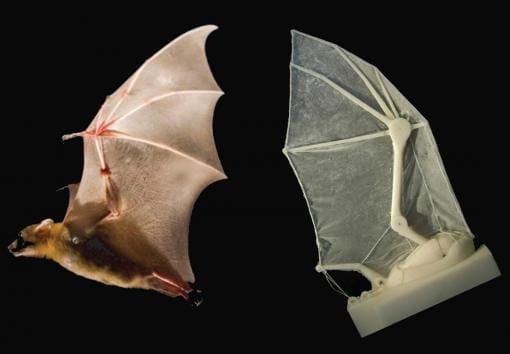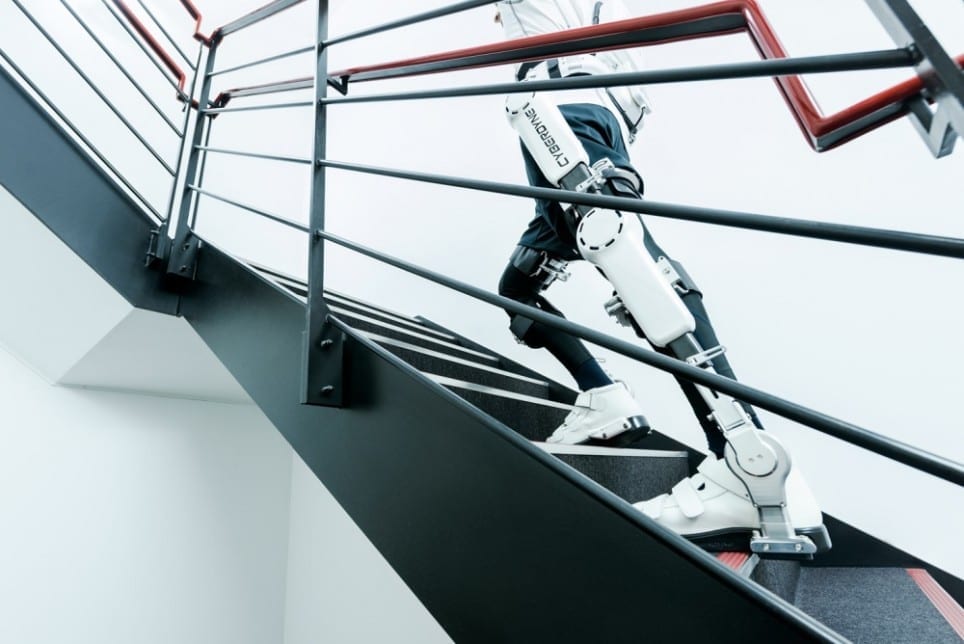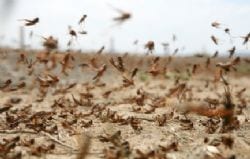The strong, flapping flight of bats offers great possibilities for the design of small aircraft, among other applications.
By building a robotic bat wing, Brown researchers have uncovered flight secrets of real bats: the function of ligaments, the elasticity of skin, the structural support of musculature, skeletal flexibility, upstroke, downstroke.
Researchers at Brown University have developed a robotic bat wing that is providing valuable new information about dynamics of flapping flight in real bats.
The robot, which mimics the wing shape and motion of the lesser dog-faced fruit bat, is designed to flap while attached to a force transducer in a wind tunnel. As the lifelike wing flaps, the force transducer records the aerodynamic forces generated by the moving wing. By measuring the power output of the three servo motors that control the robot’s seven movable joints, researchers can evaluate the energy required to execute wing movements.
Testing showed the robot can match the basic flight parameters of bats, producing enough thrust to overcome drag and enough lift to carry the weight of the model species.
A paper describing the robot and presenting results from preliminary experiments is published in the journal Bioinspiration and Biomimetics. The work was done in labs of Brown professors Kenneth Breuer and Sharon Swartz, who are the senior authors on the paper. Breuer, an engineer, and Swartz, a biologist, have studied bat flight and anatomy for years.
The faux flapper generates data that could never be collected directly from live animals, said Joseph Bahlman, a graduate student at Brown who led the project. Bats can’t fly when connected to instruments that record aerodynamic forces directly, so that isn’t an option — and bats don’t take requests.
“We can’t ask a bat to flap at a frequency of eight hertz then raise it to nine hertz so we can see what difference that makes,” Bahlman said. “They don’t really cooperate that way.”
But the model does exactly what the researchers want it to do. They can control each of its movement capabilities — kinematic parameters — individually. That way they can adjust one parameter while keeping the rest constant to isolate the effects.
“We can answer questions like, ‘Does increasing wing beat frequency improve lift and what’s the energetic cost of doing that?’” Bahlman said. “We can directly measure the relationship between these kinematic parameters, aerodynamic forces, and energetics.”
Detailed experimental results from the robot will be described in future research papers, but this first paper includes some preliminary results from a few case studies.
The Latest Bing News on:
Robotic bat wing
- Feed has no items.
The Latest Google Headlines on:
Robotic bat wing
[google_news title=”” keyword=”robotic bat wing” num_posts=”10″ blurb_length=”0″ show_thumb=”left”] [/vc_column_text]The Latest Bing News on:
Biomimetics
- 5 Stunning Photos That Demonstrate Why Fish Are Often Found In Groupson April 21, 2024 at 5:15 am
Contrary to popular belief, schools and shoals aren’t interchangeable terms. While schools refer to groups of fish that swim in a highly synchronized and organized manner, often in the same direction ...
- Study finds schools of fish can make less noise than a solitary swimmeron April 9, 2024 at 7:12 am
The work is published in Bioinspiration & Biomimetics. The team created a 3D model based on the common mackerel to simulate different numbers of fish swimming, changing up their formations ...
- What's quieter than a fish? A school of themon April 8, 2024 at 5:00 pm
The work is newly published in Bioinspiration & Biomimetics. The team created a 3D model based on the common mackerel to simulate different numbers of fish swimming, changing up their formations ...
- Biomimetics articles from across Nature Portfolioon April 3, 2024 at 5:00 pm
Biomimetics is an interdisciplinary field in which principles from engineering, chemistry and biology are applied to the synthesis of materials, synthetic systems or machines that have functions ...
- Pollen is a promising sustainable tool in the bone regeneration processon April 3, 2024 at 12:04 pm
The paper, published in the journal Biomimetics, says further experiments would be needed to explore how to best use these materials in bone regeneration applications. Future work will focus on ...
- Medical Biomimetics Market Size is projected to reach USD 54.25 billion by 2031, growing at a CAGR of 6.5%: Straits Researchon March 13, 2024 at 5:01 pm
New York, United States, March 14, 2024 (GLOBE NEWSWIRE) -- Medical biomimetics, also known as biomimicry or bioinspired technology, is a field that creates and develops novel medical treatments ...
- GCSE Design and Technology: Biomimetics - Designed by Natureon October 17, 2023 at 5:22 am
Fran Scott takes a unique look into some of the latest biomimetics technology and talks to some of the pioneers working on ways to interpret nature's biological mechanisms. This series features ...
- Companies keep copying from Earth’s greatest creator: Natureon September 13, 2023 at 12:00 am
Japanese companies continue to make high-tech advances in biomimetics, the practice of emulating designs in the wild to manufacture products and resolve problems for the human race. Recent ...
- Ferguson Biomechanics and Biomimetics Labon January 14, 2019 at 2:19 am
Our group has a long-standing focus on developing new methods and protocols to for microscopy (i.e., visualizing) and nano- and micro-mechanical testing of hydrated, heterogeneous, porous, and ...
- Analyst View: Biomimetics for the Internet of Thingson August 25, 2016 at 5:00 pm
Value stream management involves people in the organization to examine workflows and other processes to ensure they are deriving the maximum value from their efforts while eliminating waste — of ...
The Latest Google Headlines on:
Biomimetics
[google_news title=”” keyword=”biomimetics” num_posts=”10″ blurb_length=”0″ show_thumb=”left”]












